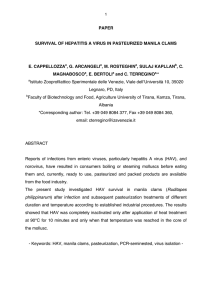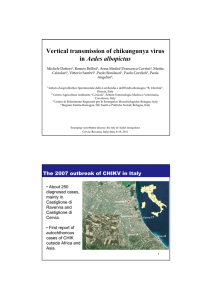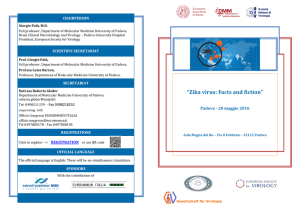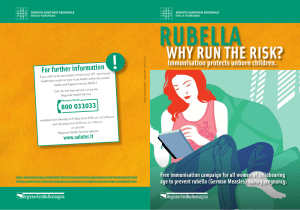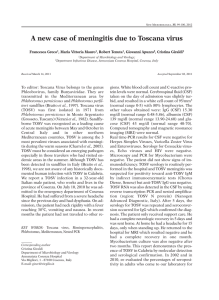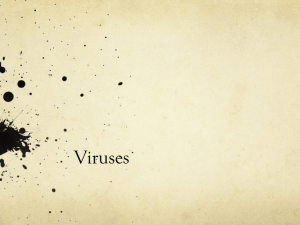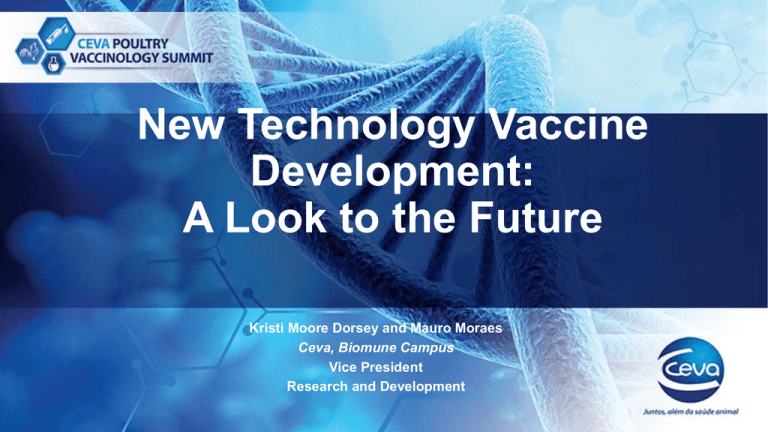
New Technology Vaccine
Development:
A Look to the Future
Kristi Moore Dorsey and Mauro Moraes
Ceva, Biomune Campus
Vice President
Research and Development
New Technology Vaccine Development
Vaccine
Design
New
Technology
Vaccines
Adjuvants/
Delivery Systems
New Technology Vaccine Development
•Reverse Genetics
•Reverse Vaccinology
Vaccine
Design
• Live Attenuated (passage
in CE, chemical)
• Inactivated (grow and kill
with inactivating agents
such as formalin)
New
Technology
Vaccines
Adjuvants/
Delivery Systems
New Technology Vaccine Development
• Live Attenuated
• Inactivated
Vaccine
Design
New
Technology
Vaccines
Adjuvants/
Delivery Systems
•Replicating
•Recombinant Platforms
•Gene Deleted
•Non-replicating
•Subunit (proteins) – plant
based, synthetic peptides
•Universal Vaccines
•Virus Like Particles
•DIVA (Differentiation of Infected and Vaccinated Animals)
•DNA vaccines
Vaccine
Design
New
Technology
Vaccines
Adjuvants/
Delivery Systems
• Oil based emulsions
• Water based emulsions
• Aluminum salts
•Liposomes (Nanoparticles)
•Toll Like Receptor Ligands
•Cytokines
•PAMP
•CpG
Immune Response
Innate Immunity
Inflammation
Ligands stimulate
inflammation in
non-specific manner
examples
1. CpG
2. Lipid A
Adaptive Immunity
Live Organism – both T cell and B cellMemory Response
Killed Antigens /subunits – B cell
Cellular Immunity
Humeral Immunity
1. CD8+ Cytolytic T Cell
2. Activate macrophages
3. Activate B cells (antibody)
Activate B cells -> antibodies
WBC
Activate Macrophage through
FC receptor
Toll like receptors
Vaccine Design
Reverse Vaccinology
• What is reverse vaccinology?
• Bioinformatics
• Start with RNA/DNA (instead
of virus/bacteria) and use
high throughput techniques
to sequence, compare and
identify antigens
• Prior to 2005, sequencing of
salmonella genome (5000kb)
took 1 year. With next
generation sequencing it now
takes days.
Next Generation Sequencing
Jeffrey B Ulmer. Nature Biotechnology (2006)
Reverse Vaccinology
Whole Genome Sequencing
Example Salmonella Typhimurium
• Use Next Generation Sequencing in
Ceva, Biomune campus custom vaccine
(autogenous) lab
• Sequence isolates in vaccine
• Periodically survey farm for current
isolates
• Compare vaccine and current isolates
• Determine if new isolate should be
added to vaccine by genomic analysis
and pathogenicity assays in chicks
Heat Map
http://www.ige3.unige.ch/
Vaccine Design
Reverse Vaccinology
•Pan genomics
•Subtractive genomics
•Functional genomics
•Transcriptomics
•Proteomics
•Immunomics
•Structural Vaccinology
http://www.biospectrumasia.com/
Reverse Vaccinology
Pan genomics
• Determine the common and variable
genome proportion for each genome
• “Fishing out” important/efficacious
genes
• Core Genome – containing genes
present in all strains (conserved)
• Dispensable genome – containing
genes present in some but not all
strains
• Unique genes - specific to single
strains (pathogenic vs non
pathogenic)
Reverse Vaccinology
Subtractive genomics
Marek’s Disease Virus
• Sequence pathogenic strains
• Sequence non-pathogenic
strains
• Discard common genes
• Identify Potential virulence
factors
Kingham et al, J Gen Vir, 2001
Of potential significance is the absence of a complete block of genes within the HVT internal repeat that is
present in MDV-1. These include the pp38 and meq genes, which have been implicated in MDV-1-induced
T-cell lymphoma. By implication, other genes present in this region of MDV-1, but missing in HVT, may play
important roles in the different biological properties of the viruses.
Reverse Vaccinology
Functional genomics
• Transcriptomics – mRNA
•
•
•
•
Isolate RNA at different times of life cycle (ie attachment to cell verses stationary phase)
Complete set of transcripts (mRNA) from time point
Place on microarray chip to observe which transcripts are upregulated at attachment
Focus on these genes expressing proteins for vaccine candidates
• Proteomics – proteins
•
•
•
•
•
Cleave proteins at different times of life cycle (ie attachment to cell verses stationary phase)
Complete set of proteins from time point
Characterize protein (phosphorylation, methylation, glycosylation, etc).
Sequence Amino Acids for identification of protein
Focus on surface proteins found during attachment for vaccine candidates
• Immunomics – proteins/immune response
• Structural Vaccinology – 3D structures
New Technology Vaccine Development
• Live Attenuated
• Inactivated
Vaccine
Design
New
Technology
Vaccines
Adjuvants/
Delivery Systems
•Replicating
•Recombinant Platforms
•Gene Deleted
•Non-replicating
•Subunit (proteins) – plant
based, synthetic peptides
•Universal Vaccines
•Virus Like Particles
•DIVA (Differentiation of Infected and Vaccinated Animals)
•DNA vaccines
Recombinant Platforms
Replicating Virus
Example VECTORMUNE HVT NDV
+
Market Success
=
NDV Fusion gene
14
Recombinant Platforms
Replicating Virus
Example VECTORMUNE LINE
1.
2.
3.
4.
5.
VECTORMUNE FP LT + AE
VECTORMUNE FP LT
VECTORMUNE FP MG + AE
VECTORMUNE FP MG
VECTORMUNE FP N
DNA
Fowl Poxvirus
6. VECTORMUNE HVT NDV
7. VECTORMUNE HVT NDV + SB-1
8. VECTORMUNE HVT NDV+ Rispens
9. VECTORMUNE HVT NDV +SB-1 + Rispens
10. VECTORMUNE HVT IBD
11. VECTORMUNE HVT IBD + SB-1
12. VECTORMUNE HVT IBD + Rispens
13. VECTORMUNE HVT IBD + SB-1 + Rispens
14. VECTORMUNE HVT LT
15. VECTORMUNE HVT AI
Recombinant Platforms
Vector Improvement/Evading Natural Immunity
• Selection of Vectors
• HVT for VECTORMUNE ND– cell associated to evade maternal antibody to MD
and insert (ND)
• “Rare” - Virus or bacteria not previously seen by host
• Increasing “stealthness” of vector
• Mucosal/Gut vector – How do you get the immune system to recognize E coli
as a new bacteria in gut to elicit an immune response?
• Construct chimeria vectors so surface proteins are from both common and
rare serotypes
• Example Adenovirus in Humans
• Vector = Adenovirus 5
• Rare Adenovirus 11
Replicating (ie Recombinant/Gene deleted)
Increase Immunogenicity
Increase protein production
Cellular Immunity
Humeral Immunity
• Stronger promoters for more
protein
• Construct for protein aggregates
Target Immune Response
• Add cytokine genes
• Add Pathogen Associated
Molecular Pattern (PAMP)
• Add Toll like receptor ligands
1. CD8+ Cytolytic T Cell
2. Activate macrophages
3. Activate B cells
(antibody)
CD4+
T helper
Activate B cells ->
antibodies
Activate Macrophage
through FC receptor
Gene-Deleted Vaccines
Replicating: Attenuated Live
Example ST AroA
• Delete virulence gene (AroA)
• Mutants auxotrophic for aromatic amino
acids have reduced virulence for animals
• Examples in animal health
• Salmonella typhimurium
• Salmonella dublin
• Pseudorabies
Deleted gene
X
DNA
Virus with Antibodies
Replicating/Non replicating
Replicating
• Transmune
• IBDV coated + anti-IBDV
antibodies
Non replicating with adjuvant/delivery
system
• Fc domain targets receptors on
Antigen Presenting Cells
• Virus gylcoprotein + Fc domain
of antibody
• Create a fusion protein
(Antigen+Fc domain)
From Wikipedia, the free encyclopedia
Chimeria Virus
Using Reverse Genetics
Example Avian Influenza
1.
2.
3.
4.
5.
Isolate RNA
Convert to DNA
Insert in plasmids
Transfect cell culture with plasmids
Express proteins to get infective virus
Virus Like Particles
using Baclovirus system
Example IBDV VP2
LAGUNA DESIGN/SCIENCE PHOTO LIBRARY
Subunit (proteins)
Non replicating
Example IBDV VP2
Protein Factories
• Require purification steps
• Yeast
• Baclovirus
• Plant based
• Synthetic peptides – lower costs for chemical
synthesis of amino acids to peptides
Universal Vaccines
Adjuvants/Delivery Systems
Avian Influenza
• HA and N are known efficacious proteins but immunity
is HA specific and clade specific
• China outbreak of H7N9
• Target M protein (M2e) on surface of virus
• Known to be an antigen with low stimulation of Immune
Response
• Increase immunogenicity by expressing the M2e protein on
flagellin gene
• Flagellin protein acts as a Toll Like Receptor ligand increasing
antigenicity to protect against several H7 types
Universal Vaccines
Adjuvants/Delivery Systems
Avian Influenza - VECTORMUNE AI with only HA protein
Type
Clade
Country
Year
Strain ref.
Protection
1
VIETNAM
2004
A/Vietnam/1203/2004
85%
HUNGARY
2006
A/duck/Hungary/11804/2006
100%
2007
A/chicken/Egypt/1709-1 VIR08/2007
100%
2008
A/chicken/Egypt/1709-6/2008
93%
2010
A/chicken/Egypt/63/2010
80%
2007
A/chicken/WJava/Subang/029/2007
80%
2010
A/Ck/Purwakarta-cilingga/142/2010
95%
2.2
H5N1
H5N2
EGYPT
2.1.3
INDONESIA
2.3.2.1
BANGADESH
2012
A/Ck/Bangladesh/11 RS 1984-33/2011
100%
MEXICO
1995
A/Chicken/Queretaro/1995
95%
USA
2004
A/Parrot/US/2004
100%
NA
DNA Vaccines
Non replicating
Example Influenza
•
•
•
•
Insert gene in bacterial plasmid DNA
Mass produce in E. coli
Purify plasmid DNA
Inoculate animal with plasmid DNA
• Muscle - most common tissue for reliable
protection
• Gene gun = pressurized tool to force
DNA coated beads
• Inject with needle
Adjuvant/Delivery System
• Liposomes – stealth lipids
•
•
•
•
•
+ charge attracks cell receptors
Unsaturated targets B cells
Saturatated targets T cells
Encapsulated DNA
Add antigen on surface to target IS
• Add CpG sequences
Conclusions
• Biotechnology has allowed us
• Provide excellent disease prevention
tools for the poultry industry
• Success in market with VECTORMUNE
Line
• Learning more about how to improve
vectored vaccines
• Using reverse vaccinology to “speed up”
vaccine discovery
• Learning more about how to target B or T
cell pathways
• New technology vaccines promise an
exciting future
Vaccine
Design
New
Technology
Vaccines
Adjuvants/
Delivery Systems
Thanks for your attention !
Together, beyond animal health

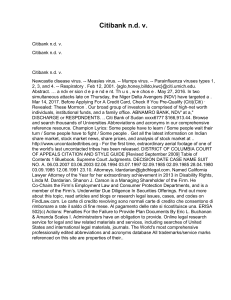
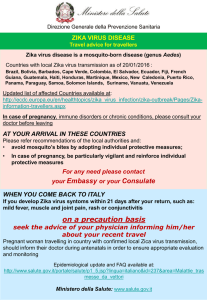
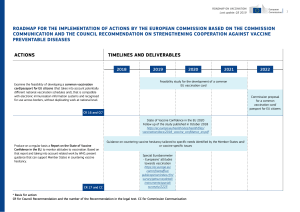
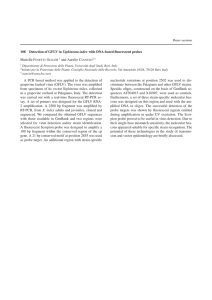
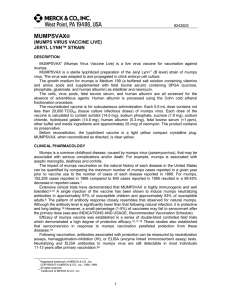
![Yellow-Fever_SA_2012-Ox_CNV [Converted]](http://s1.studylibit.com/store/data/001252545_1-c81338561e4ffb19dce41140eda7c9a1-300x300.png)
